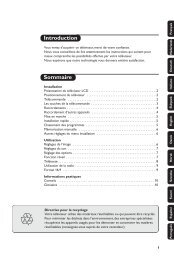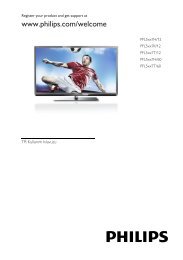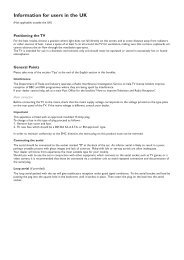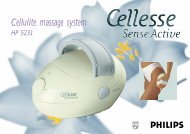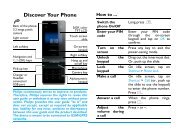Create successful ePaper yourself
Turn your PDF publications into a flip-book with our unique Google optimized e-Paper software.
IMPORTANT SAFETY INSTRUCTIONS<br />
Read before operating equipment<br />
1. Read these instructions.<br />
2. Keep these instructions.<br />
3. Heed all warnings.<br />
4. Follow all instructions.<br />
5. Do not use this apparatus near water.<br />
6. Clean only with a dry cloth.<br />
7. Do not block any of the ventilation openings. Install in<br />
accordance with the manufacturers instructions.<br />
8. Do not install near any heat sources such as radiators, heat<br />
registers, stoves, or other apparatus (including amplifiers)<br />
that produce heat.<br />
9. Do not defeat the safety purpose of the polarized or grounding-type<br />
plug. A polarized plug has two blades with one<br />
wider than the other. A grounding type plug has two blades<br />
and third grounding prong. The wide blade or third prong<br />
are provided for your safety. When the provided plug does<br />
not fit into your outlet, consult an electrician for replacement<br />
of the obsolete outlet.<br />
10. Protect the power cord from being walked on or pinched<br />
particularly at plugs, convenience receptacles, and the point<br />
where they exit from the apparatus.<br />
11. Only use attachments/accessories specified by the manufacturer.<br />
12. Use only with a cart, stand, tripod, bracket, or table<br />
specified by the manufacturer, or sold with the apparatus.<br />
When a cart is used, use caution when<br />
moving the cart/apparatus combination to avoid<br />
injury from tip-over.<br />
13. Unplug this apparatus during lightning storms or when<br />
unused for long periods of time.<br />
14. Refer all servicing to qualified service personnel. Servicing<br />
is required when the apparatus has been damaged in any<br />
way, such as power-supply cord or plug is damaged, liquid<br />
has been spilled or objects have fallen into apparatus, the<br />
apparatus has been exposed to rain or moisture, does not<br />
operate normally, or has been dropped.<br />
15. This product may contain lead and mercury. Disposal of<br />
these materials may be regulated due to environmental considerations.<br />
For disposal or recycling information, please<br />
contact your local authorities or the Electronic Industries<br />
Alliance: www.eiae.org<br />
16. Damage Requiring Service - The appliance should be<br />
serviced by qualified service personnel when:<br />
A. The power supply cord or the plug has been damaged;<br />
or<br />
B. Objects have fallen, or liquid has been spilled into the<br />
appliance; or<br />
C. The appliance has been exposed to rain; or<br />
D. The appliance does not appear to operate normally or<br />
exhibits a marked change in performance; or<br />
E. The appliance has been dropped, or the enclosure<br />
damaged.<br />
17. Tilt/Stability - All televisions must comply with recommended<br />
international global safety standards for tilt and stability<br />
properties of its cabinet design.<br />
• Do not compromise these design standards by applying<br />
excessive pull force to the front, or top, of the cabinet which<br />
could ultimately overturn the product.<br />
• Also, do not endanger yourself, or children, by placing<br />
electronic equipment/toys on the top of the cabinet. Such<br />
items could unsuspectingly fall from the top of the set and<br />
cause product damage and/or personal injury.<br />
18. Wall or Ceiling Mounting - The appliance should be<br />
mounted to a wall or ceiling only as recommended by the<br />
manufacturer.<br />
19. Power Lines - An outdoor antenna should be located away<br />
from power lines.<br />
20. Outdoor Antenna Grounding - If an outside antenna is<br />
connected to the receiver, be sure the antenna system is<br />
grounded so as to provide some protection against voltage<br />
surges and built up static charges.<br />
Section 810 of the National Electric Code, ANSI/NFPA No.<br />
70-1984, provides information with respect to proper<br />
grounding of the mats and supporting structure grounding of<br />
the lead-in wire to an antenna discharge unit, size of<br />
grounding connectors, location of antenna-discharge unit,<br />
connection to grounding electrodes and requirements for<br />
the grounding electrode. See Figure below.<br />
21. Object and Liquid Entry - Care should be taken so that<br />
objects do not fall and liquids are not spilled into the enclosure<br />
through openings.<br />
Note to the CATV system installer: This reminder is provided to call the CATV system installer's attention to Article 820-40 of the NEC that provides<br />
guidelines for proper grounding and, in particular, specifies that the cable ground shall be connected to the grounding system of the building, as close<br />
to the point of cable entry as practical.<br />
Example of Antenna Grounding<br />
as per NEC - National Electric Code<br />
GROUND CLAMP<br />
ANTENNA LEAD IN WIRE<br />
ANTENNA DISCHARGE UNIT (NEC SECTION 810-20)<br />
GROUNDING CONDUCTORS (NEC SECTION 810-21)<br />
GROUND CLAMPS<br />
ELECTRIC SERVICE EQUIPMENT<br />
POWER SERVICE GROUNDING ELECTRODE SYSTEM (NEC ART 250, PART H)<br />
3



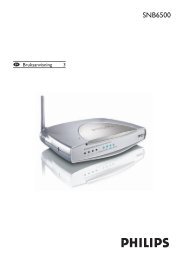
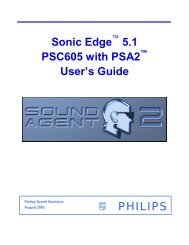
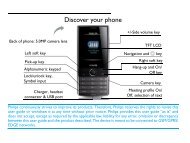
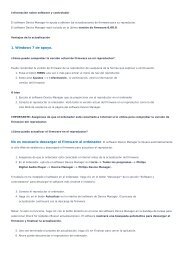
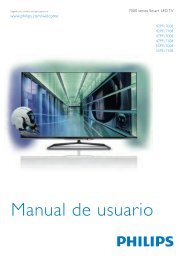
![03_[DE] - Philips](https://img.yumpu.com/25100096/1/184x260/03-de-philips.jpg?quality=85)
